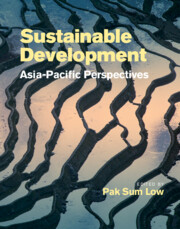Book contents
- Sustainable Development: Asia-Pacific Perspectives
- Sustainable Development: Asia-Pacific Perspectives
- Copyright page
- Dedication
- Contents
- Notes on contributors
- Peer reviewers
- Editor’s note
- Foreword
- Foreword
- Foreword
- Foreword
- Foreword
- Environmental keystones: Remembering Dr Mostafa Kamal Tolba
- Remembering Dr Mostafa Kamal Tolba
- Remembering Dr Mostafa Kamal Tolba
- Acronyms and abbreviations
- SI prefixes
- Unit abbreviations
- Chemical formulae
- Part I Sustainable Development: Theories and Practices
- Part II Sustainable Development: Challenges and Opportunities
- 17 Scientific responses in an era of global change
- 18 Government communication on transboundary haze: The nexus between public health and tourism
- 19 Biomass energy prospects: A promising fuel for sustainable development in Asia and the Pacific
- 20 Pathways to a more sustainable electricity sector in India
- 21 Gender equality and energy access: Barriers to maximizing development effectiveness in the SAARC region
- 22 The biosphere and the interactions between stratospheric ozone depletion and climate change
- 23 The political challenge of linking climate change and sustainable development policies: Risks and prospects
- 24 Social vulnerability to climate change in Cambodia, Lao PDR, and Vietnam
- 25 Sustainable development in Bangladesh: Bridging the SDGs and climate action
- 26 Sustainable development in Pakistan: Vulnerabilities and opportunities
- 27 Beyond protected areas: Biodiversity conservation and global change in Asia and the Pacific
- 28 Causes of land-use change and biodiversity loss in Monsoon Asia
- 29 Assessing linkages between land use and biodiversity: A case study from the Eastern Himalayas using low-cost, high-return survey technology
- 30 Where to invade next: Inaction on biological invasions threatens sustainability in a small island developing state of the tropical South Pacific
- 31 Did the Indian Ocean tsunami trigger a shift towards disaster risk reduction?
- 32 Cyclone Nargis and disaster risk management in Myanmar
- Index
- Endmatter
- References
20 - Pathways to a more sustainable electricity sector in India
from Part II - Sustainable Development: Challenges and Opportunities
Published online by Cambridge University Press: 23 December 2021
- Sustainable Development: Asia-Pacific Perspectives
- Sustainable Development: Asia-Pacific Perspectives
- Copyright page
- Dedication
- Contents
- Notes on contributors
- Peer reviewers
- Editor’s note
- Foreword
- Foreword
- Foreword
- Foreword
- Foreword
- Environmental keystones: Remembering Dr Mostafa Kamal Tolba
- Remembering Dr Mostafa Kamal Tolba
- Remembering Dr Mostafa Kamal Tolba
- Acronyms and abbreviations
- SI prefixes
- Unit abbreviations
- Chemical formulae
- Part I Sustainable Development: Theories and Practices
- Part II Sustainable Development: Challenges and Opportunities
- 17 Scientific responses in an era of global change
- 18 Government communication on transboundary haze: The nexus between public health and tourism
- 19 Biomass energy prospects: A promising fuel for sustainable development in Asia and the Pacific
- 20 Pathways to a more sustainable electricity sector in India
- 21 Gender equality and energy access: Barriers to maximizing development effectiveness in the SAARC region
- 22 The biosphere and the interactions between stratospheric ozone depletion and climate change
- 23 The political challenge of linking climate change and sustainable development policies: Risks and prospects
- 24 Social vulnerability to climate change in Cambodia, Lao PDR, and Vietnam
- 25 Sustainable development in Bangladesh: Bridging the SDGs and climate action
- 26 Sustainable development in Pakistan: Vulnerabilities and opportunities
- 27 Beyond protected areas: Biodiversity conservation and global change in Asia and the Pacific
- 28 Causes of land-use change and biodiversity loss in Monsoon Asia
- 29 Assessing linkages between land use and biodiversity: A case study from the Eastern Himalayas using low-cost, high-return survey technology
- 30 Where to invade next: Inaction on biological invasions threatens sustainability in a small island developing state of the tropical South Pacific
- 31 Did the Indian Ocean tsunami trigger a shift towards disaster risk reduction?
- 32 Cyclone Nargis and disaster risk management in Myanmar
- Index
- Endmatter
- References
Summary
India is the third-largest emitter of greenhouse gases in the world, and its coal-dominated electricity sector contributes approximately half of these. In addition, air pollution from burning coal is a serious challenge for public health. India also has approximately 200 million people without access to electricity and therefore has low per capita electricity consumption. These are unflattering realities when India is also expected to be among the fastest-growing economies in the world for the next few decades.
At the Paris summit in 2015, India committed to increasing the share of non-fossil electric generation capacity to 40% by 2030. The recent decline in the cost of solar photovoltaic systems and wind generation, and strong policy support for renewables-based distributed generation and micro-grids, make this target achievable. While the role of nuclear power in meeting this goal is uncertain, India’s re-entry in global nuclear trade and commerce following the 2008 civilian nuclear agreement with the United States and negotiation of a partial safeguards agreement with the International Atomic Energy Agency (IAEA) have revived interest in a major expansion programme. Reducing coal’s share in the Indian electricity sector, expanding electrification of transport, and improving efficiency can reduce India’s urban air pollution problems. At the same time, improving access and quality of service are key components of the United Nations’ Sustainable Development Goals (SDG). In this chapter, we analyse the challenges and benefits of increasing the share of renewables and nuclear power in India’s electricity system.
Keywords
- Type
- Chapter
- Information
- Sustainable Development: Asia-Pacific Perspectives , pp. 257 - 270Publisher: Cambridge University PressPrint publication year: 2022

